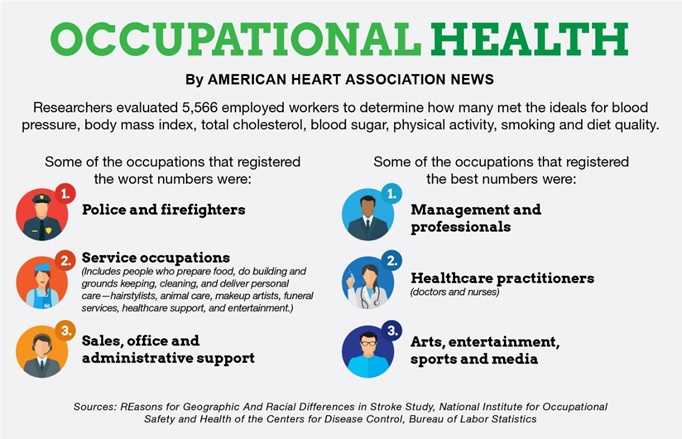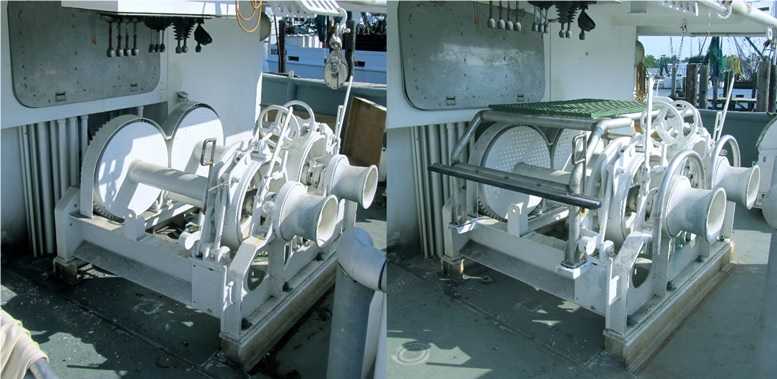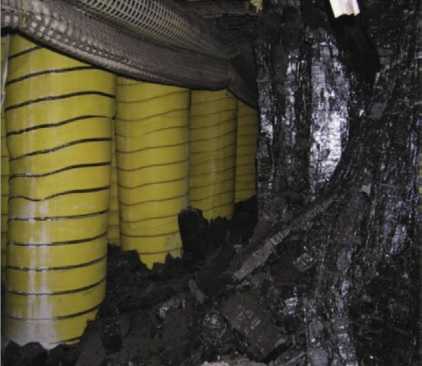NIOSH Research Rounds
NIOSH Research Rounds is a monthly bulletin of selected research at the National Institute for Occupational Safety and Health.
Volume 2, Number 10 (April 2017)
Ideal Cardiovascular Health Varies by Occupation
Risk factors for cardiovascular disease (diseases that affect the heart and blood vessels and include stroke) vary considerably by occupation according to a new study by NIOSH and the University of Alabama at Birmingham. Although previous research looked at cardiovascular disease risk among U.S. workers, the current study is the first of its kind. Investigators comprehensively analyzed biometrics, or clinical measures, and behavioral risk factors in a national sample of workers employed across a wide range of occupations, which they report in a paper published in the American Journal of Preventive Medicine.
Cardiovascular disease is largely preventable but remains a major cause of death and long-term disability worldwide. In the United States, heart disease is the leading cause of death, while stroke is the third-leading cause of death. More than half of those in the U.S. population with cardiovascular disease are under age 60.
For this study, participants included workers aged 45 years and older (the fastest growing segment of the U.S. workforce) participating in a national study of heart disease and stroke, known as REGARDS, or the REasons for Geographic and Racial Differences in Stroke. As part of that study, investigators published information about cardiovascular disease and related risk factors for 6,282 workers. Using computer-assisted telephone interviews, self-administered questionnaires, and clinical exams, they obtained information about heart disease and stroke, as well as seven risk factors: (1) elevated blood sugar, (2) elevated blood cholesterol, (3) high blood pressure, (4) elevated body mass index (BMI) or height-to-weight measurement, (5) poor diet quality, (6) inadequate physical activity, and (7) smoking. For each study participant, investigators categorized the risk factors as ideal, intermediate, and poor, according to criteria from the American Heart Association.
From this information, NIOSH and university partners estimated the number of U.S. workers with ideal, intermediate, or poor cardiovascular health. They found that cardiovascular disease affects 11.6%, or an estimated 10 million U.S. workers age 45 and older. Overall, more managers and workers in professional occupations had ideal cardiovascular health, while service, sales, as well as office and administrative support, workers had less ideal cardiovascular health. For the four behavioral factors—smoking, physical activity, diet quality, and BMI—computer and healthcare support workers were the least likely to have ideal cardiovascular health. Workers in protective services and food preparation and serving were the least likely to score as ideal on the clinical factors of blood sugar, blood cholesterol, and blood pressure. These findings are consistent with increasing evidence linking social and environmental work conditions to varying levels of cardiovascular health and disease among workers employed in diverse jobs. These findings also highlight the need for more public health programs targeting cardiovascular disease and related risk factors among workers.

Risk factors for cardiovascular disease vary considerably by occupation, according to a new study. Image courtesy of the American Heart Association.
More information is available:
- Prevalence of Cardiovascular Health by Occupation – A Cross-Sectional Analysis among U.S. Workers Aged ≥45 Years
- NIOSH Cardiovascular Disease and Occupational Factors
- Division of Surveillance, Hazard Evaluations, and Field Studies
- Reasons for Geographic and Racial Differences in Stroke (REGARDS) Study
In This Issue
NIOSH Research Rounds is Brought to You By:
- John Howard, M.D., Director
- Fred Blosser, Editor in Chief
- Anne Blank, Story Editor
- Tanya Headley, Contributing Editor
- John Lechliter, Copy Editor
- Glenn Doyle, Technical Lead
- Tonya White, Technical Support
Get Email Updates
Subscribe to the NIOSH Research Rounds Newsletter, enter your email address:
Respirator Use Low among Surveyed Farm Operators

Respirators like the NIOSH-approved N95 respirators pictured above can help protect workers by filtering at least 95% of potentially dangerous airborne particles. Photo from CDC/Debora Cartagena.
Respirators reduce exposure to harmful airborne substances, but most farm operators who manage a farm’s day-to-day activities do not wear them, according to a new NIOSH study in the Journal of Agromedicine. The study highlights the need for more education about respirator use among these workers.
Respirators cover the nose and mouth to filter dust, mold, and other substances in the workplace that can cause breathing problems. Although the best protection is to remove these substances entirely from the air, that is not always possible, especially in agricultural settings. Respirators like the NIOSH-approved N95 respirator, however, can help protect workers by filtering at least 95% of potentially dangerous airborne particles and are a critical part of personal protective equipment.
To estimate respirator use and associated factors among U.S. farm operators, scientists analyzed results from a nationwide survey conducted by the U.S. Department of Agriculture’s National Agricultural Statistics Service on the request of NIOSH. This 2011 telephone survey included 11,210 active farm operators, or their partners, who voluntarily answered questions about their respirator use in the past 12 months. The survey also included questions about asthma status, pesticide use, age, marital status, sex, smoking status, geographic region, and farm sales, type, and acreage. It did not collect information on specific circumstances requiring a respirator, such as the type of pesticide used when farm operators wore one.
Overall, survey participants reported low use of respirators, with just over a third reporting that they had used them in the past year. Farm operators with asthma, however, were significantly more likely to use them compared to those without asthma. In this group, more than half reported that they used respirators, compared to less than half of farm operators who did not have asthma. A history of an asthma attack at work correlated with even greater use, with farm operators who had experienced such an attack 11 times more likely to wear respirators compared to those who said they had not had a work-related asthma attack. In another promising finding, farm operators who worked with pesticides were significantly more likely to report that they used respirators than farm operators who did not work with pesticides. According to the scientists, future research is necessary to identify factors that might affect farm operators’ use of respirators.
More information is available:
NIOSH Designs and Tests Device to Prevent Winch Injuries at Sea
After a 15-year-old boy died when a rotating winch drum on a shrimp vessel in the Gulf of Mexico caught his clothing, the U.S. Coast Guard asked NIOSH to identify ways to prevent winch entanglements in the U.S. southern shrimp fleet. With reports of 35 injuries, including 8 deaths, involving winches in the U.S. southern shrimp fleet, winch entanglements are a serious problem.
Commercial fishing is one of the most dangerous jobs in the United States. The U.S. southern shrimp fleet is more dangerous than other fleets due to the hazard of entanglements in deck machinery, often in deck winches. Shrimp fishermen use two types of deck winches on their side-trawl vessels. Main deck winches are the larger of the two and are typically driven mechanically from the boat engine. Shrimp fishermen also use a “try-net” winch, which is electrically driven and deploys a smaller net used to gauge the quality and quantity of the catch going into the main nets. Each type of winch uses spools of wire rope to deploy and retrieve the nets.
In the current study, NIOSH engineers looked at both types of deck winches to develop safety interventions that could reduce the occurrences and the severity of injuries from winch entanglements. After identifying the three most common main winches in the U.S. southern shrimp fleet, three stationary guards were designed and built that fit over the main winches. Shrimp boat owners and crews fishing in the Gulf of Mexico collaborated with NIOSH to test the guards at sea. Those test results were used to improve future prototype designs.
For the try-net winch, electrical controls are typically mounted where the deckhand can reach them while standing but are out of their reach if they were to become entangled in the winch. NIOSH engineers designed an Auxiliary Stop system, reachable to an entanglement victim, to stop power to the winch motor in an emergency. Tests of this device are also currently underway.

An unprotected winch, left, and the same winch outfitted with a stationery guard, right, to prevent entanglement. Photo from NIOSH.
More information is available:
Pumpable Roof Supports Tested in Simulated Mine

Pumpable roof supports, shown above in an underground coal mine, stabilize the mine roof to prevent collapse during coal removal. Photo from NIOSH.
Underground mine safety depends upon many factors, including special equipment that stabilizes the mine roof to prevent collapse during coal removal. Known as pumpable roof supports, these collapsible, cylindrical bags are attached to the mine roof. Once attached, the bags are filled with cement through hoses threaded through holes in the mine roof. Wire bands encircling the bags maintain the cylindrical shape as the bags fill with cement.
Underground coal mines have used two types of pumpable roof supports for the past 20 years; however, little is known about differences in performance between the two main types. From the outside, the supports may look similar, but, on the inside, they differ considerably depending on what type of cement is used to fill them. Two types of cement are commonly used, one of which is calcium-based, while the other is limestone and clay-based.
To compare the differences between supports filled with the two different cements, NIOSH investigators tested pumpable roof supports more than 160 times over 7 years in the NIOSH Mine Roof Simulator. Located in Bruceton, Pennsylvania, the simulator provides a safe and controlled environment that mimics the conditions of an underground coal mine, including the thousands of pounds of load taken up by the roof supports once coal is extracted. The tests showed that the calcium-based cement was significantly stiffer compared to the limestone and clay-based cement, according to the study published in the International Journal of Mining Science and Technology. Both types of cement decreased in strength as the load increased and they began to crack, which often occurs with brittle cements. Up to a point, the bag contains the cracking material and the support can still bear significant weight. Eventually, however, an increasing load will cause the surrounding bag to tear, which leads to a rapid decrease in the pumpable support’s strength. Accordingly, the investigators now plan to study supports using less brittle materials than the two standard cements.
More information is available:
Disclaimer
Mention of any company or product does not constitute endorsement by NIOSH.
- Page last reviewed: April 12, 2017
- Page last updated: April 12, 2017
- Content source:
- National Institute for Occupational Safety and Health (NIOSH) Office of the Director


 ShareCompartir
ShareCompartir